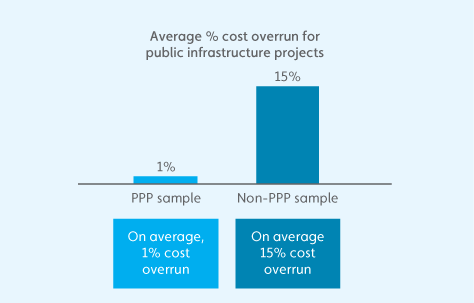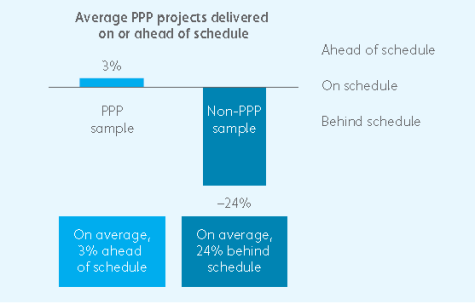The benefits of using PPPs to procure Social Infrastructure
Traditionally, New Zealand Social Infrastructure projects have been funded, operated and maintained by the public sector. However, there is international evidence to suggest that procurement through a PPP can deliver several benefits to the public sector, including:
Value for money
in contrast to traditional procurement methods, the private sector has a financial incentive to optimise construction and on-going management such as building repairs and maintenance. This can result in the selection of more durable materials, which increases initial construction costs but reduces the whole-of-life costs of the project; and
PPPs bring private sector expertise and innovation to the infrastructure associated with the provision of public services, which can deliver greater value for money relative to traditional procurement methods. Recent Australian experience shows that, on average, cost overruns in PPP projects are 1% of the total project cost compared to 15% of the total project cost for non-PPP projects12.

Risk management
- In a PPP, the private sector partner has an incentive to complete construction on, or ahead of, time and provide high-quality services, as payments do not typically commence until the asset has been built and an agreed level of service is being provided. Recent Australian experience shows that, on a value-weighted average basis, PPP projects are delivered 3% ahead of schedule compared to 24% behind schedule for non-PPP projects13 ; and

- private partners in PPPs that receive availability-based payment streams have a commercial incentive to manage the ongoing quality, cost and availability of the infrastructure.
Delivery on government priorities
- PPPs allow the public sector to spread the payment for infrastructure assets over a number of years and may allow projects to be brought forward compared with traditional procurement approaches; and
- PPPs allow the public sector to focus on the provision of frontline services rather than managing capital works and maintenance. For example, United Kingdom studies suggest that educational performance rises in PPP schools14.
13 Ibid 14 KPMG, “PFI in School Building – Does it Infl uence Educational Outcomes?” and “Investment in School Facilities and PFI – Do They Play a Role in Educational Outcomes?”